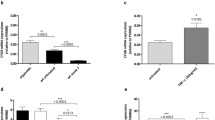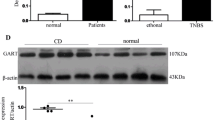Abstract
Xanthine oxidoreductase (XOR) serves as the primary source of hydrogen peroxide and superoxide anions in the intestinal mucosa. However, its specific contribution to the progression of colonic disease remains unclear. In this study, we investigated the role of XOR in ulcerative colitis (UC) and attempted to identify the underlying mechanisms. We used the dextran sulfate sodium (DSS)–induced mouse model to mimic UC and observed that XOR inhibitors, allopurinol and diphenyleneiodonium sulfate (DPI), significantly alleviated UC in mice. In addition, treatment with cobalt chloride (CoCl2) and 1% O2 increased the expression of XOR and induced DNA oxidative damage in colonic epithelial cells. Furthermore, we identified that XOR accumulation in the nucleus may directly cause DNA oxidative damage and regulates HIF1α protein levels. In addition, allopurinol effectively protected colon epithelial cells from CoCl2-induced DNA damage. Altogether, our data provided evidence that XOR could induce DNA damage under hypoxic conditions, indicating a significant role of XOR in the initiation and early development of colitis-associated colorectal cancer (CAC).





Similar content being viewed by others
Data Availability
The data that support the findings of this study are available from the corresponding author upon reasonable request.
References
Ibrahim, C.B., O.C. Aroniadis, and L.J. Brandt. 2010. On the role of ischemia in the pathogenesis of IBD: a review. Inflammatory Bowel Disease 16: 696–702. https://doi.org/10.1002/ibd.21061.
Baumgart, D.C., and S.R. Carding. 2007. Inflammatory bowel disease: cause and immunobiology. Lancet 369: 1627–40. https://doi.org/10.1016/s0140-6736(07)60750-8.
Porter, R.J., R. Kalla, and G.T. Ho. 2020. Ulcerative colitis: recent advances in the understanding of disease pathogenesis. F1000Research 9. https://doi.org/10.12688/f1000research.20805.1.
Colgan, S.P., and C.T. Taylor. 2010. Hypoxia: an alarm signal during intestinal inflammation. Nature Reviews Gastroenterology and Hepatology 7: 281–7. https://doi.org/10.1038/nrgastro.2010.39.
Iborra, M., I. Moret, F. Rausell, G. Bastida, M. Aguas, E. Cerrillo, et al. 2011. Role of oxidative stress and antioxidant enzymes in Crohn’s disease. Biochemical Society Transactions 39: 1102–6. https://doi.org/10.1042/bst0391102.
Roessner, A., D. Kuester, P. Malfertheiner, and R. Schneider-Stock. 2008. Oxidative stress in ulcerative colitis-associated carcinogenesis. Pathology Research and Practice 204: 511–24. https://doi.org/10.1016/j.prp.2008.04.011.
Battelli, M.G., E.D. Corte, and F. Stirpe. 1972. Xanthine oxidase type D (dehydrogenase) in the intestine and other organs of the rat. Biochemical Journal 126: 747–9. https://doi.org/10.1042/bj1260747.
Krenitsky, T.A., J.V. Tuttle, E.L. Cattau Jr., and P.A. Wang. 1974. comparison of the distribution and electron acceptor specificities of xanthine oxidase and aldehyde oxidase. Comparative Biochemistry and Physiology-B 49: 687–703. https://doi.org/10.1016/0305-0491(74)90256-9.
Auscher, C., N. Amory, C. Pasquier, and F. Delbarre. 1977. Localization of xanthine oxidase acitivty in hepatic tissue. A new histochemical method. Advances in Experimental Medicine and Biology 76a: 605–9. PMID:855733.
Roy, R.S. 1985. The role of Xanthine oxidase in superoxide-mediated ischemic injury (Xanthine dehydrogenase)[M]: University of South Alabama.
Morpeth, F.F. 1983. Studies on the specificity toward aldehyde substrates and steady-state kinetics of xanthine oxidase. Biochimica et Biophysica Acta 744: 328–34. https://doi.org/10.1016/0167-4838(83)90207-8.
Bortolotti, M., L. Polito, M.G. Battelli, and A. Bolognesi. 2021. Xanthine oxidoreductase: one enzyme for multiple physiological tasks. Redox Biology 41. https://doi.org/10.1016/j.redox.2021.101882.
Martin, H.M., J.T. Hancock, V. Salisbury, and R. Harrison. 2004. Role of xanthine oxidoreductase as an antimicrobial agent. Infection and Immunity 72: 4933–9. https://doi.org/10.1128/iai.72.9.4933-4939.2004.
Cantu-Medellin, N., and E.E. Kelley. 2013. Xanthine oxidoreductase-catalyzed reactive species generation: a process in critical need of reevaluation. Redox Biology 1: 353–8. https://doi.org/10.1016/j.redox.2013.05.002.
Li, H., C. Zhang, H. Zhang, and H. Li. 2021. Xanthine oxidoreductase promotes the progression of colitis-associated colorectal cancer by causing DNA damage and mediating macrophage M1 polarization. European Journal of Pharmacology 906: 174270. https://doi.org/10.1016/j.ejphar.2021.174270.
Shepherd, A.P. 1982. Metabolic control of intestinal oxygenation and blood flow. Federation Proceedings 41: 2084–2089. PMID:7075783.
Taylor, C.T., and S.P. Colgan. 2007. Hypoxia and gastrointestinal disease. Journal of Molecular Medicine (Berl) 85: 1295–300. https://doi.org/10.1007/s00109-007-0277-z.
Granger, D.N., G. Rutili, and J.M. McCord. 1981. Superoxide radicals in feline intestinal ischemia. Gastroenterology 81: 22–29. PMID:6263743.
Parks, D.A., G.B. Bulkley, D.N. Granger, S.R. Hamilton, and J.M. McCord. 1982. Ischemic injury in the cat small intestine: Role of superoxide radicals. Gastroenterology 82: 9–15. PMID:6273253.
Itoh, M., and P.H. Guth. 1985. Role of oxygen-derived free radicals in hemorrhagic shock-induced gastric lesions in the rat. Gastroenterology 88: 1162–7. https://doi.org/10.1016/s0016-5085(85)80075-5.
Adkison, D., M.E. Höllwarth, J.N. Benoit, D.A. Parks, J.M. McCord, and D.N. Granger. 1986. Role of free radicals in ischemia-reperfusion injury to the liver. Acta Physiologica Scandinavica Supplementum 548: 101–107. PMID:3463123.
Amirshahrokhi, K. 2019. Febuxostat attenuates ulcerative colitis by the inhibition of NF-κB, proinflammatory cytokines, and oxidative stress in mice. International Immunopharmacology 76: 105884. https://doi.org/10.1016/j.intimp.2019.105884.
El-Mahdy, N.A., D.A. Saleh, M.S. Amer, and S.E. Abu-Risha. 2020. Role of allopurinol and febuxostat in the amelioration of dextran-induced colitis in rats. European Journal of Pharmaceutical Sciences 141: 105116. https://doi.org/10.1016/j.ejps.2019.105116.
Neufert, C., C. Becker, and M.F. Neurath. 2007. An inducible mouse model of colon carcinogenesis for the analysis of sporadic and inflammation-driven tumor progression. Nature Protocols 2: 1998–2004. https://doi.org/10.1038/nprot.2007.279.
Cooper, H.S., S.N. Murthy, R.S. Shah, and D.J. Sedergran. 1993. Clinicopathologic study of dextran sulfate sodium experimental murine colitis. Laboratory Investigation 69: 238–249. PMID:8350599.
Dmitrieva, N.I., K. Cui, D.A. Kitchaev, K. Zhao, and M.B. Burg. 2011. DNA double-strand breaks induced by high NaCl occur predominantly in gene deserts. Proceedings of the National Academy of Sciences of the United States of America 108: 20796–801. https://doi.org/10.1073/pnas.1114677108.
Houston, M., A. Estevez, P. Chumley, M. Aslan, S. Marklund, D.A. Parks, et al. 1999. Binding of xanthine oxidase to vascular endothelium. Kinetic characterization and oxidative impairment of nitric oxide-dependent signaling. Journal of Biological Chemistry 274: 4985–94. https://doi.org/10.1074/jbc.274.8.4985.
Xue, X., S. Ramakrishnan, E. Anderson, M. Taylor, E.M. Zimmermann, J.R. Spence, et al. 2013. Endothelial PAS domain protein 1 activates the inflammatory response in the intestinal epithelium to promote colitis in mice. Gastroenterology 145: 831–41. https://doi.org/10.1053/j.gastro.2013.07.010.
Kundu, T.K., M. Velayutham, and J.L. Zweier. 2012. Aldehyde oxidase functions as a superoxide generating NADH oxidase: an important redox regulated pathway of cellular oxygen radical formation. Biochemistry 51: 2930–9. https://doi.org/10.1021/bi3000879.
Kono, H., I. Rusyn, T. Uesugi, S. Yamashina, H.D. Connor, A. Dikalova, et al. 2001. Diphenyleneiodonium sulfate, an NADPH oxidase inhibitor, prevents early alcohol-induced liver injury in the rat. American Journal of Physiology-Gastrointestinal and Liver Physiology 280: G1005-12. https://doi.org/10.1152/ajpgi.2001.280.5.G1005.
Lam, G., V. Apostolopoulos, A. Zulli, and K. Nurgali. 2015. NADPH oxidases and inflammatory bowel disease. Current Medicinal Chemistry 22: 2100–9. https://doi.org/10.2174/0929867322666150416095114.
Ivanov, V., E. Shakhristova, E. Stepovaya, N. Litvjakov, N. Perekucha, O. Nosareva, et al. 2018. Oxidative stress in the pathogenesis of type 1 diabetes: the role of adipocyte xanthine oxidase. Bulletin of Siberian Medicine 16: 134–143. https://doi.org/10.20538/1682-0363-2017-4-134-143.
Poles, M.Z., N. Bódi, M. Bagyánszki, É. Fekete, A.T. Mészáros, G. Varga, et al. 2018. Reduction of nitrosative stress by methane: neuroprotection through xanthine oxidoreductase inhibition in a rat model of mesenteric ischemia-reperfusion. Free Radical Biology and Medicine 120: 160–169. https://doi.org/10.1016/j.freeradbiomed.2018.03.024.
Caty, M.G., D.J. Schmeling, H.P. Friedl, K.T. Oldham, K.S. Guice, and G.O. Till. 1990. Histamine: a promoter of xanthine oxidase activity in intestinal ischemia/reperfusion. Journal of Pediatric Surgery 25: 218–22; discussion 222–3. https://doi.org/10.1016/0022-3468(90)90406-y.
Semenza, G.L. 2003. Targeting HIF-1 for cancer therapy. Nature Reviews Cancer 3: 721–32. https://doi.org/10.1038/nrc1187.
Yuan, Y., G. Hilliard, T. Ferguson, and D.E. Millhorn. 2003. Cobalt inhibits the interaction between hypoxia-inducible factor-α and von Hippel-Lindau protein by direct binding to hypoxia-inducible factor-α. Journal of Biological Chemistry 278: 15911–15916. https://doi.org/10.1074/jbc.M300463200.
Epstein, A.C., J.M. Gleadle, L.A. McNeill, K.S. Hewitson, J. O’Rourke, D.R. Mole, et al. 2001. C. elegans EGL-9 and mammalian homologs define a family of dioxygenases that regulate HIF by prolyl hydroxylation. Cell 107: 43–54. https://doi.org/10.1016/s0092-8674(01)00507-4.
Lee, G., H.S. Won, Y.M. Lee, J.W. Choi, T.I. Oh, J.H. Jang, et al. 2016. Oxidative dimerization of PHD2 is responsible for its inactivation and contributes to metabolic reprogramming via HIF-1α activation. Scientific Reports 6: 18928. https://doi.org/10.1038/srep18928.
Guzy, R.D., B. Sharma, E. Bell, N.S. Chandel, and P.T. Schumacker. 2008. Loss of the SdhB, but Not the SdhA, subunit of complex II triggers reactive oxygen species-dependent hypoxia-inducible factor activation and tumorigenesis. Molecular and Cellular Biology 28: 718–31. https://doi.org/10.1128/mcb.01338-07.
Hagen, T. 2012. Oxygen versus reactive oxygen in the regulation of HIF-1alpha: the balance tips. Biochemistry Research International 2012: 436981. https://doi.org/10.1155/2012/436981.
Galván-Peña, S., and L.A. O’Neill. 2014. Metabolic reprograming in macrophage polarization. Frontiers in Immunology 5: 420. https://doi.org/10.3389/fimmu.2014.00420.
Louis, N.A., K.E. Hamilton, G. Canny, L.L. Shekels, S.B. Ho, and S.P. Colgan. 2006. Selective induction of mucin-3 by hypoxia in intestinal epithelia. Journal of Cellular Biochemistry 99: 1616–27. https://doi.org/10.1002/jcb.20947.
Corcoran, S.E., and L.A. O’Neill. 2016. HIF1α and metabolic reprogramming in inflammation. Journal of Clinical Investigation 126: 3699–3707. https://doi.org/10.1172/jci84431.
Funding
This work supported by the National Natural Science Foundation of China (81773064, 31972973 and 31530056), National Youth 1000 Talents Plan, the Jiangsu Specially-Appointed Professor Program, Jiangsu Province Recruitment Plan for High-level, Innovative and Entrepreneurial Talents (Innovative Research Team), and Collaborative innovation center of food safety and quality control in Jiangsu Province.
Author information
Authors and Affiliations
Contributions
Hongling Li, Qi Zhang, and Haitao Li designed and supervised the experiments. Hongling Li prepared the manuscript. Hongling Li, Weiyu Han, and Yupeng Wang performed experiments.
Corresponding authors
Ethics declarations
Competing Interests
The authors declare no competing interests.
Additional information
Publisher's Note
Springer Nature remains neutral with regard to jurisdictional claims in published maps and institutional affiliations.
SUPPLEMENTARY INFORMATION
Below is the link to the electronic supplementary material.
Rights and permissions
Springer Nature or its licensor (e.g. a society or other partner) holds exclusive rights to this article under a publishing agreement with the author(s) or other rightsholder(s); author self-archiving of the accepted manuscript version of this article is solely governed by the terms of such publishing agreement and applicable law.
About this article
Cite this article
Li, H., Li, X., Wang, Y. et al. Hypoxia-Mediated Upregulation of Xanthine Oxidoreductase Causes DNA Damage of Colonic Epithelial Cells in Colitis. Inflammation (2024). https://doi.org/10.1007/s10753-024-01966-y
Received:
Revised:
Accepted:
Published:
DOI: https://doi.org/10.1007/s10753-024-01966-y




